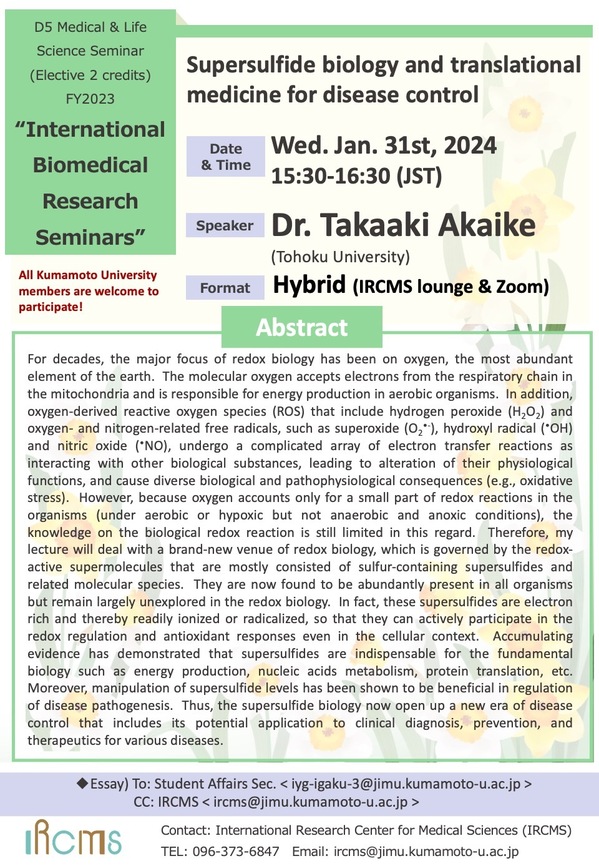- HOME
- News & Events
- [Jan. 31] D5 Seminar-Dr. Takaaki Akaike (Tohoku University)
News & Events
[Jan. 31] D5 Seminar-Dr. Takaaki Akaike (Tohoku University)
January 12 2024
The "D5 Medical & Life Science Seminar" course will be offered by International Research Center for Medical Sciences (IRCMS). It will run from May 2023 to March 2024, with lectures given by scientists who are affiliated with IRCMS or in collaboration with researchers at IRCMS. The lectures will be given once a month, in English, and by leading scientists in the relevant research field. Students will be taught: 1) how normal physiological functions are maintained in the human body; 2) how these systems become abnormal under certain pathophysiologic conditions; 3) why stem cells are important in animal development and homeostasis; 4) how stem cell-based approaches can help us understand disease mechanisms and find potential cure for diseases related to stem cell malfunction (e.g., cancer, aging).
Anyone who wants to join is welcome.
For students who have registered for the course, please check your attendance in Moodle.
Date : January 31st, 2024 (Wednesday)
Format : Hybrid
Time : 15:30 - 16:30 (JST)
Speaker : Dr. Takaaki Akaike (Tohoku University)
Title : Supersulfide biology and translational medicine for disease control
Abstract :
For decades, the major focus of redox biology has been on oxygen, the most abundant element of the earth. The molecular oxygen accepts electrons from the respiratory chain in the mitochondria and is responsible for energy production in aerobic organisms. In addition, oxygen-derived reactive oxygen species (ROS) that include hydrogen peroxide (H2O2) and oxygen- and nitrogen-related free radicals, such as superoxide (O2•-), hydroxyl radical (•OH) and nitric oxide (•NO), undergo a complicated array of electron transfer reactions as interacting with other biological substances, leading to alteration of their physiological functions, and cause diverse biological and pathophysiological consequences (e.g., oxidative stress). However, because oxygen accounts only for a small part of redox reactions in the organisms (under aerobic or hypoxic but not anaerobic and anoxic conditions), the knowledge on the biological redox reaction is still limited in this regard. Therefore, my lecture will deal with a brand-new venue of redox biology, which is governed by the redox-active supermolecules that are mostly consisted of sulfur-containing supersulfides and related molecular species. They are now found to be abundantly present in all organisms but remain largely unexplored in the redox biology. In fact, these supersulfides are electron rich and thereby readily ionized or radicalized, so that they can actively participate in the redox regulation and antioxidant responses even in the cellular context. Accumulating evidence has demonstrated that supersulfides are indispensable for the fundamental biology such as energy production, nucleic acids metabolism, protein translation, etc. Moreover, manipulation of supersulfide levels has been shown to be beneficial in regulation of disease pathogenesis. Thus, the supersulfide biology now open up a new era of disease control that includes its potential application to clinical diagnosis, prevention, and therapeutics for various diseases.
2-3 major papers:
1. Kasamatsu, S., Nishimura, A., Alam, M. M., Morita, M., Shimoda, K., Matsunaga, T., Jung, M., Ogata, S., Barayeu, U., Ida, T., Nishida, M., Nishimura, A., Motohashi, H., & Akaike, T. Supersulfide catalysis for nitric oxide and aldehyde metabolism. Science Advances 9, eadg8631 (2023). doi: 10.1126/sciadv.adg8631.
2. Matsunaga, T., Sano, H., Takita, K., Morita, M., Yamanaka, S., Ichikawa, T., Numakura, T., Ida, T., Jung, M., Ogata, S., Yoon, S., Fujino, N., Kyogoku, Y., Sasaki, Y., Koarai, A., Tamada, T., Toyama, A., Nakabayashi, T., Kageyama, L., Kyuwa, S., Inaba, K., Watanabe, S., Nagy, P., Sawa, T., Oshiumi, H., Ichinose, M., Yamada, M., Sugiura, H., Wei, F.-Y., Motohashi, H., & Akaike, T. Supersulphides provide airway protection in viral and chronic lung diseases. Nature Communications 14, 4476 (2023). doi: 10.1038/s41467-023- 40182-4.
3. Akaike, T., Ida, T., Wei, F. Y., Nishida, M., Kumagai, Y., Alam, M. M., Ihara, H., Sawa, T., Matsunaga, T., Kasamatsu, S., Nishimura, A., Morita, M., Tomizawa, K., Nishimura, A., Watanabe, S., Inaba, K., Shima, H., Tanuma, N., Jung, M., Fujii, S., Watanabe, Y., Ohmuraya, M., Nagy, P., Feelisch, M., Fukuto, J. M., & Motohashi, H. Cysteinyl-tRNA synthetase governs cysteine polysulfidation and mitochondrial bioenergetics. Nature Communications 8, 1177 (2017). doi: 10.1038/s41467-017-01311-y.
Flyer: (Click to enlarge)

